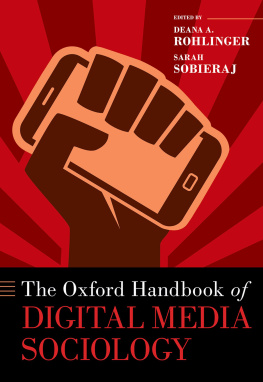Intimacy at Work:
How Digital Media Bring Private Life to the Workplace
Stefana Broadbent
First published 2016 by Left Coast Press, Inc.
Published 2016 by Routledge
2 Park Square, Milton Park, Abingdon, Oxon OX14 4RN
711 Third Avenue, New York, NY 10017, USA
Routledge is an imprint of the Taylor & Francis Group, an informa business
Copyright 2016 Taylor & Francis
All rights reserved. No part of this book may be reprinted or reproduced or utilised in any form or by any electronic, mechanical, or other means, now known or hereafter invented, including photocopying and recording, or in any information storage or retrieval system, without permission in writing from the publishers.
Notice:
Product or corporate names may be trademarks or registered trademarks, and are used only for identification and explanation without intent to infringe.
Library of Congress Cataloging-in-Publication Data:
Broadbent, Stefana.
[Lintimit au travail. English]
Intimacy at work : how digital media bring private life to the workplace / Stefana Broadbent.
pages cm.(Anthropology and business ; Volume 2)
Includes bibliographical references and index.
ISBN 978-1-62958-094-4 (hardback)
ISBN 978-1-62958-095-1 (paperback)
ISBN 978-1-62958-096-8 (institutional eBook)
ISBN 978-1-62958-097-5 (consumer eBook)
1. Personal Internet use in the workplace. 2. Cell phonesSocial aspects. 3. Information technologySocial aspects. 4. Social media. 5. Work environment. 6. Work-life balance. 7. Right to privacy. I. Title.
HF5549.5.P39B7613 2015
302.35dc23
2015026293
ISBN 978-1-62958-095-1 paperback
ISBN 978-1-62958-094-4 hardback
Contents
This book is about very personal emotions. It tells the stories of people who have been using technology to express their feelings and empathise with people around them. I am infinitely grateful to everyone who has been so generous as to spend time with me reflecting and explaining their intimate thoughts. I know I have not been able to do justice to the richness and depth of the relationships they have recounted.
I also wish to thank my students at UCL in London and the ENSAD in Paris who have helped me with precious interviews and observations. I am especially grateful to Maria Ramirez Angel with whom we shared findings and interviews for many years. My colleagues at Swisscom, Valerie Bauwens, Petra Hutter, Caroline Hirst, Daniel Boos, were indefatigable research partners.
I am indebted to many people for my intellectual meanderings. Francesco Cara, Dan Sperber, and Ed Hutchins have an enduring influence on my understanding of social and cognitive phenomena. Eliana Adler Segre taught me the importance of theories of emotions. My colleagues at UCL Haidy Gesimar, and Daniel Miller have introduced me to the mysteries of material culture. Claire Lobet Maris and Nicole Dewandre have helped me understand the impact of attention. Geoff Mulgan and Stian Westlake at Nesta are opening my eyes to the world of governance and policy.
Finally I wish to thank Jack Meinhardt and the editors at Left Coast Press, Inc., for their patience and support and Timothy de Waal Malefyt for his immediate interest in the book.
In the last fifteen years 5 billion people have gleefully adopted the opportunity to stay in continuous contact with people they love.
Their days are now dotted with small interactions with family, partners, and friends through texts, pictures, likes, e-mails, and phone calls. Close scrutiny of what people actually do with all the channels they have at their disposal shows an intensification of exchanges with few close ties, often less than five, that lead to the strengthening of these relationships. All the data on mobile and Internet communication we have at our disposal shows that users in all countries are having short and frequent exchanges with the people who are closest to them. This constant and ubiquitous link between individuals and their loved ones is very emotionally intense, and the feeling of being always within reach provides a profound sense of safety and comfort. Both the staggering speed of adoption (it took 120 years to get 1.2 billion subscribers to use fixed phones, whereas it took only from 2002 to 2008 to increase the number of mobile phones from 1 billion to 4.1 billion), and the universality of the communication practices that have emerged indicate the depth of the emotional response to these channels. However, these billions of short conversations, messages, and endearments are seriously subverting peoples relations to the key institutions they inhabit, such as their workplaces or schools. Environments where individuals were expected to be isolated from their private social sphere, such as offices, factory floors, hospitals, or classrooms, are now accessible to personal exchanges. These private conversations are challenging a number of well-rooted conceptions on the need to remove people from their personal social environment in order for them to be productive and effective.
Most organisations for the last 150 years had, in fact, banned the private sphere from their premises, as the majority of Western society has functioned on the principle that attention, isolation, and productivity are strictly interrelated. Although some form of contact from the workplace was possible after the introduction of the telephone in offices in the late 1930s, social factors such as status, power, and trust meant that only the highest professional ranks were allowed to do so. Only managers and directors had their own external line. The generalisation of personal digital devices, PCs first and then mobile phones, has meant that private communication has now become possible at all levels of the professional and educational hierarchy, blue-collar workers and managers alike. Not surprisingly, most institutions initially set limits and regulations on where, when, and how much people were allowed to use their private channels. Educational institutions systematically introduced measures to limit mobile device use; administrations initially blocked access to social networking websites; and manufacturing, retail, and transport companies prohibited the use of phones during working hours, with sanctions leading to dismissal in the most serious cases. Restrictions emerged and still are the tightest in the settings where people are trusted the least. In many environments where control is exerted, it is simply assumed that without restrictions, people will abuse the access and be incapable of controlling their attention and their commitment.
What the exceptionally rapid adoption of personal communication devices has shown is that the division of the private and professional realms is arbitrary and often unwelcome. When given the possibility, most people seem to want to be able to keep in touch with their personal social sphere whenever they feel the need for it. Paradoxically, in the last century, while we developed a culture that elevated the family and intimate life to the main social space of individuals, a space that is supposed to provide all the comfort, sustenance, and happiness that the public realm cannot offer, people were made to work and learn in environments that cut them off from their closest ties. From an emotional perspective, therefore, people are living in a society that overemphasises the role of intimate relationships and throws onto the family the ultimate responsibility of caring and nurturing the individual, while these same people are also spending a large portion of their day severed from those relationships. In light of the current profound transformation of the labour market, which is leading to a greater fragmentation and instability of work, with longer periods of under- or unemployment, the role of strong personal ties is ever more prominent. It is not surprising, then, that the moment a channel of communication emerged that could be used to reconnect the personal and professional realms, it was immediately adopted.












